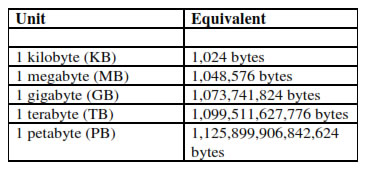CHAPTER FIVE
NUMBER BASES
5.2.1. Bit
The term bit was introduced by an American statistician and computer scientist, John Tukey in 1946, as an abbreviation of the term binary digit. Bit is the smallest unit of data or information that can be stored in a computer. It is usually, represented by the numbers 1 and 0- binary numbers. In computing these numbers correspond to the states of on and off, true and false, or yes and no.
5.2.2. Nibble
A nibble is a group of 4 bits. The smallest value a nibble can hold is 0000 and the largest number is 1111.
Nibble is used by early processors such as
5.2.3. Byte
The term byte was formulated by Dr. Werner Buchholz of IBM in 1956. A byte is composed of eight bits. A byte is the unit most computers use to represent a character such as a letter, number, or typographic symbol (for example, "g", "5", or "?"). Computer storage is usually measured in byte multiples. For example, an 520 MB hard drive holds a nominal 520 million bytes - or megabytes - of data.

5.2.4. Word
Bytes are combined into groups of 1 to 8 bytes called words. The size of the words used by a computer’s central processing unit (CPU) depends on the bit-processing ability of the CPU. A 32-bit processor, for example, can use words that are up to four bytes long (32 bits).
5.2.5. Kilobyte, Megabyte And Gigabyte
5.2.5.1. Kilobyte
Kilobyte is used for measuring the amount of data or information a computer can store. Kilobyte is expressed as kb. A kilobyte (KB) is 1,024 bytes, not one thousand bytes as might be expected, because computers use binary (base two) math, instead of a decimal (base ten) system.
5.2.5.2. Megabyte
Computer storage and memory is often measured in megabytes (MB) and gigabytes (GB). A medium-sized novel contains about 1MB of information. 1MB is 1,024 kilobytes, or 1,048,576 (1024x1024) bytes, not one million bytes.
5.2.5.3. Gigabyte
Similarly, one 1GB is 1,024MB, or 1,073,741,824 (1024x1024x1024) bytes. A terabyte (TB) is 1,024GB; 1TB is about the same amount of information as all of the books in a large library, or roughly 1,610 CDs worth of data.
5.2.5.4. Differences between Kilobyte, Megabyte And Gigabyte

5.2.6. Kilometer, Kilogram and Kilobyte
5.2.6.1. Kilometer
Kilometer is used for measuring distance. For instance, the distance from Abuja to Lagos is one thousand one hundred kilometers. The unit is expressed as km.
5.2.6.2. Kilogram
Kilogram is used for measuring the weight of an item. That means it is to measure how heavy is an item, a material or a person is. For instance the weight of Mr. Stephen is 45kg. The unit is expressed as Kg
EXERCISE
1. What is meant by the number system?
2. List and define the different number systems| Page 46 | Page 47 | Page 48 |
Copyright@2015. Digital Vision Digital Content Development Unit. www.digitalvision.net.ng